Best Cookware for Electric Stoves: Expert Guide for Smart Cooking
Updated: 9 Jul 2025
185
Ever feel like your food cooks faster in the center but stays raw on the edges? Many homeowners blame the stove, but the real issue often lies in the wrong cookware. If your pans are warped, too lightweight, or not compatible with flat burners, your food won’t cook evenly, and that’s frustrating.
Choosing the right pots and pans isn’t just about style or brand. It’s about safety, efficiency, and protecting your stove from damage.
“The right pan can make or break your cooking game—especially on an electric stove.” — StoveMastery Experts
In this guide, I’ll walk you through the best cookware for electric stoves based on real experience, expert advice, and industry insights. You’ll learn what works, what doesn’t, and how to make smart cookware choices that last.
How Electric Stoves Work (And Why It Matters for Your Cookware)
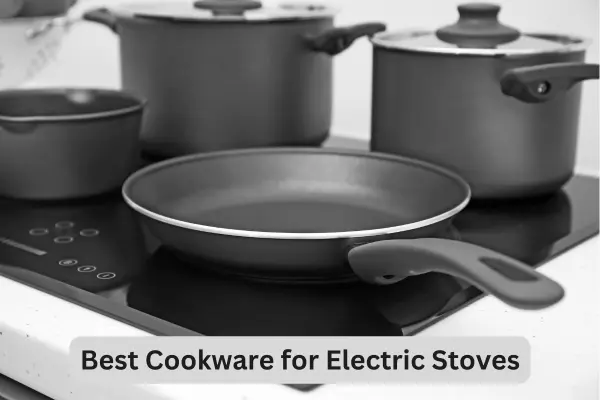
Electric stoves don’t work like gas. They use heating coils or glass-ceramic tops to transfer heat. With gas burners, flames wrap around the pan. But with electric stoves, heat comes from direct contact with the burner surface.
So, if your pan isn’t touching the stove fully, you lose heat, and food cooks unevenly. That’s why using flat-bottom cookware for electric stoves is so important. The better the contact, the better the heat transfer.
What Makes Cookware Electric Stove-Friendly?
Electric stoves have flat, solid heating surfaces. Here’s what matters:
- Flat bottom – For even heat distribution.
- Medium to heavy weight – Lightweight pans wobble and heat unevenly.
- Durable material – To withstand repeated heating and cooling cycles.
Electric stoves need the right cookware to work well. If you use the wrong type, your stove won’t reach its full potential.
What is the Best Cookware for Electric Stoves?
Now that you understand how your stove works, let’s talk about what to cook with. Not all pots and pans are a good match for electric cooktops.
The best cookware for electric stoves must check these boxes:
- Flat bottom
- Stable weight
- Quality material
- Stove-safe construction
1. Stainless Steel Cookware
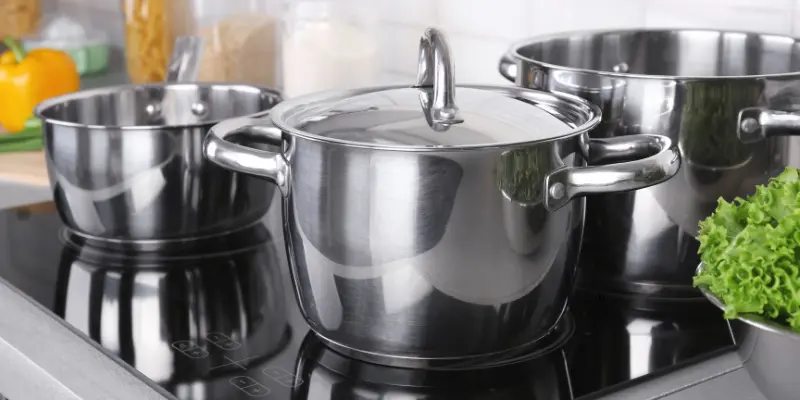
Stainless steel cookware for electric stoves is a top choice. It’s strong, durable, and doesn’t react with food. For best results, go for multi-ply or tri-ply stainless steel—they distribute heat better.
Pros:
- Scratch-resistant
- Dishwasher safe
- Lasts for years
Best Brands: All-Clad, Cuisinart Multiclad Pro
2. Cast Iron (Raw or Enameled)
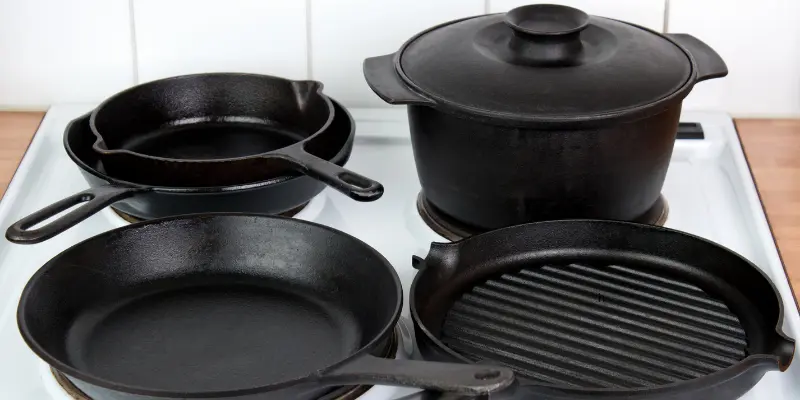
Many people ask, can I use cast iron on electric stove? Yes—but with care. Cast iron holds heat well and is great for frying or slow cooking.
If you use a glass top, choose enameled cast iron. It’s smoother and less likely to scratch.
Tip: Always lift, never slide.
Best Brands: Lodge, Le Creuset
3. Hard-Anodized Aluminum
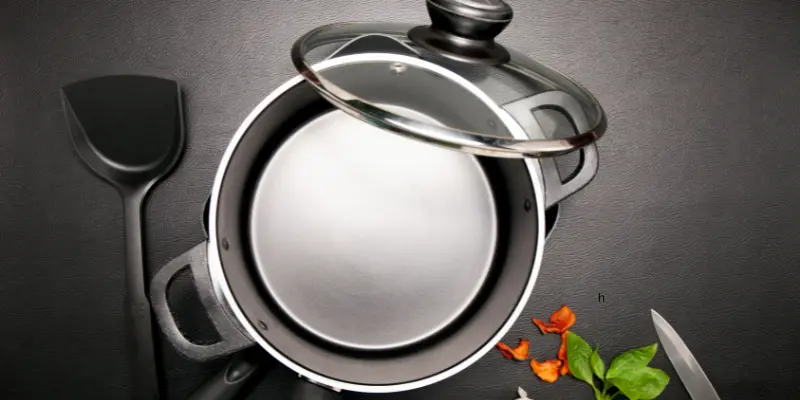
This is one of the best types of non stick cookware for electric stoves. It’s durable, lightweight, and resists warping.
Pros:
- Cooks evenly
- Easy to clean
- Oven safe (in most cases)
Best Brands: Calphalon Premier, T-fal Ultimate
4. Copper Core Cookware
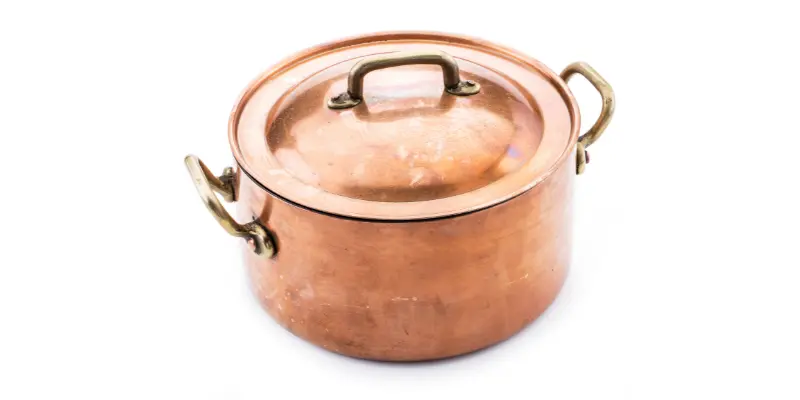
Copper heats fast—great for precision cooking. But raw copper scratches easily. Choose copper with a stainless steel base.
Best Brands: Mauviel, Hestan CopperBond
Want to explore more cookware materials? Check out our detailed guide on Different Types of Cookware Materials
What Cookware to Avoid on Electric Stoves
Not all cookware is made for electric stoves. Some types cause damage, cook unevenly, or just don’t last long. Here’s what you should avoid:
- Warped or Uneven Bottoms
Electric stoves need flat-bottom cookware. If the base is uneven or warped, the pan won’t sit right. That means poor heat transfer and uneven results. This is especially bad for coil electric stoves.
They may be cheap, but they don’t hold heat well. Thin pans burn food fast and often bend over time. They’re also prone to warping when exposed to high heat.
- Glass or Ceramic Cookware
While safe in the oven, they heat slowly on electric stovetops. On glass top electric stoves, they’re also a scratch risk. Avoid it unless the manufacturer specifically says it’s stovetop-safe.
- Non-Stick with Plastic Handles
Many low-cost non-stick cookware for electric stoves come with plastic handles. These handles can melt if the pan gets too hot or goes into the oven. Always check for oven-safe labels.
You may check out our guide for safe cookware options, 10 Best Non-Toxic Cookware of 2025
- Cookware with Rounded or Textured Bottoms
Your cookware must match the flat surface of an electric burner. Rounded or textured bases reduce contact and waste heat.
Buying Guide: How to Choose the Best Cookware for Your Electric Stove
Finding the best cookware for electric stoves doesn’t need to be hard. Just keep a few key things in mind.
1. Flat Bottoms Are Non-Negotiable
This is rule #1. Whether you’re using a coil or smooth glass-top electric stove, the base must sit flat for consistent heating.
2. Weight Matters
Too light? It wobbles. Too heavy? It scratches. Choose medium-weight or enameled cast iron with care. Heavier pans usually cook more evenly.
3. Oven-Safe Construction
Electric stove users often move dishes from the stovetop to the oven. Make sure the cookware is oven-safe, especially if you’re buying sets.
4. Material Quality
Each material offers benefits:
- Stainless steel – Long-lasting and durable
- Hard-anodized aluminum – Great heat distribution, non-stick
- Enameled cast iron – Perfect for glass top stoves, retains heat
- Copper core – Fast heat response, ideal for precision
5. Compatibility with Your Stove Type
If you’re using a coil electric stove, you’re better off with heavier cookware that can press into the coils. If you’re using a glass top stove, smoother and more delicate cookware works better.
6. Set or Single Pieces?
Buying a full set is great if you’re starting from scratch. However, mixing high-quality single pieces from different brands can offer better performance and save money.
Suggested Top Brands (2025 Picks)
| Brand | Best For | Why It Stands Out |
|---|---|---|
| All-Clad | Stainless Steel | Pro-grade, even heating |
| Calphalon | Hard-Anodized | Affordable and durable |
| T-fal | Budget Non-Stick | Easy to use, oven-safe |
| Le Creuset | Enameled Cast Iron | Stylish, perfect for glass tops |
| Cuisinart | Multiclad Stainless Steel | Value-driven, tri-ply design |
“Cookware is your stove’s partner—choose wisely, or they won’t get along.” — Home Cooking Review, 2024
Maintenance Tips to Protect Your Cookware & Electric Stove
Taking care of your cookware matters just as much as choosing it. Here’s how to make it last:
Tips for Daily Use
- Always lift your cookware—don’t drag it.
- Match the pan size to the burner.
- Use medium heat unless searing.
- Avoid empty preheating with non-stick pans.
Cleaning Do’s and Don’ts
- Let pans cool before washing.
- Use soft sponges—not steel wool.
- Avoid dishwasher for hard-anodized cookware, unless labeled safe.
- Clean the stove top after every use to avoid scratches.
FAQs
Can I Use Induction Cookware on an Electric Stove?
Yes, you can. Induction-compatible pans usually have ferromagnetic bases, which work just fine on electric stoves. However, induction cookware is often heavier and more expensive.
Do I need different cookware for coil and glass-top electric stoves?
Yes, slightly. Coil electric stoves can handle heavier cookware. But glass tops scratch easily. So, smooth-bottom and enameled cookware is safer.
Can I test if my cookware is safe for electric stoves?
Yes. Place a ruler flat across the pan’s bottom. If you see a gap, it’s warped. Also, check the manufacturer’s label. Look for “flat bottom” or “electric stove safe.”
Is Non-Stick Cookware Safe on Electric Stoves?
Yes, but choose high-quality, PFOA-free non-stick pans with flat, stable bases. Avoid thin, cheap ones—they degrade fast.
Will a Cast Iron Pan Crack My Glass-Top Electric Stove?
It can if you drag or drop it. Be careful—always lift and place. Enameled cast iron is safer.
Why Is My Food Burning in the Middle of the Pan?
This usually happens with thin pans. Electric stoves heat from a central coil, and a lightweight pan can’t distribute that heat properly.
Final Thoughts
Choosing the best cookware for electric stoves is not just about style—it’s about performance, safety, and better cooking results. Think about your cooking needs, budget, and stove type before buying. Always look for cookware labeled as compatible with electric stoves.
Also, take care of your pans. Clean them gently, don’t drag them on the stovetop, and store them properly. This helps both your cookware and stove last longer.
In short, if you want better meals and longer-lasting kitchen tools, invest in the right cookware. It’s a smart and simple upgrade every electric stove user should make.
References
https://news.unl.edu/article/study-property-of-non-stick-pans-improves-solar-cell-efficiency
https://www.healthline.com/nutrition/nonstick-cookware-safety
Please Write Your Comments